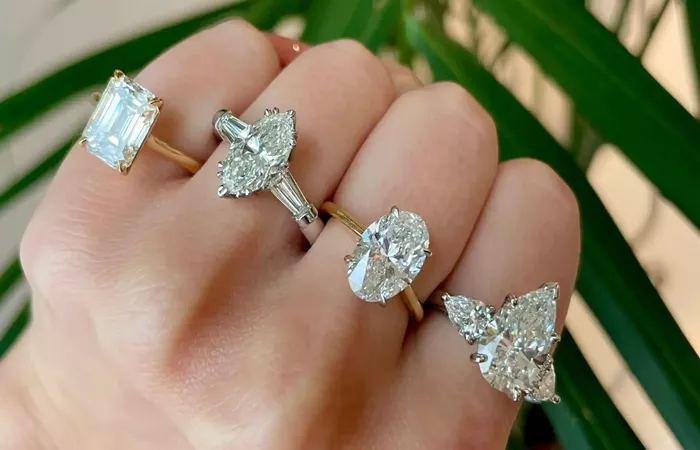Diamonds are among the most sought-after gemstones. Their brilliance and rarity make them ideal for engagement rings, pendants, and earrings. But when people mention a “14K diamond,” confusion can arise. The term combines both a diamond and a 14-karat gold setting. These are separate elements. To understand their total value, each must be analyzed separately.
What Does 14K Mean?
“14K” refers to the purity of gold. Pure gold is 24 karats. Therefore, 14K gold means the alloy is 58.3% gold and 41.7% other metals. These may include silver, copper, or nickel. The 14K mark is commonly found in jewelry sold in the U.S. and many parts of Europe. It is prized for its durability and reasonable gold content.
Diamonds Are Graded Separately
Diamonds are not graded by karat. Instead, they are measured by carat (weight), cut, color, and clarity. This is called the 4Cs grading system. The diamond’s quality greatly impacts its value. A 1-carat diamond can range from $1,000 to $25,000 or more, depending on its characteristics.
Common Misconceptions About “14K Diamonds”
Many believe 14K refers to the diamond. This is incorrect. 14K only applies to the gold setting. The diamond itself may be of any size or grade. Sellers may advertise “14K diamond rings” or “14K diamond necklaces,” but the number only applies to the metal.
How to Determine the Value of 14K Diamond Jewelry
The value of a 14K diamond piece includes two components:
- The gold setting (14K)
- The diamond itself
Each must be appraised separately. Let’s look at each element in detail.
1. Evaluating the 14K Gold Setting
Gold is valued by weight. A 14K gold setting is 58.3% pure. If the jewelry weighs 10 grams, about 5.83 grams are pure gold. The current gold price per gram determines its worth. As of June 2025, gold trades around $70 per gram. Therefore, 5.83 grams of gold is worth approximately $408.10.
2. Evaluating the Diamond
The diamond’s value depends on the 4Cs:
- Carat: The diamond’s weight.
- Cut: Quality of the diamond’s proportions and polish.
- Color: Degree of colorlessness, graded from D (colorless) to Z (light color).
- Clarity: Presence of internal or external flaws.
Let’s consider an example. A 1-carat diamond with a very good cut, F color, and VS1 clarity might be worth $8,000. A similar diamond with lower specs (J color, SI2 clarity) could be worth $2,500 or less.
Combined Value: An Example
Imagine a ring with a 1-carat VS1 diamond set in 5 grams of 14K gold. Gold value = ~$204.5. Diamond value = ~$8,000. Total market value = ~$8,200. The retail price may be higher due to labor, brand, and market markups.
Market Trends and Resale Value
New jewelry is priced higher than resale pieces. This is due to branding, design, and craftsmanship. However, if you try to resell a 14K diamond ring, expect 30%-60% of its retail value. Diamond resale is affected by demand, certification, and condition.
Certifications Boost Value
Certified diamonds sell better. Laboratories like GIA, IGI, and AGS issue detailed grading reports. These reports give buyers confidence. Uncertified diamonds often fetch lower prices. Always ask for a certificate when buying or selling.
Role of Design and Brand
High-end brands like Tiffany & Co. or Cartier can increase a ring’s value. Their craftsmanship and market prestige drive up prices. A non-branded 14K ring with the same specs may be far cheaper than a branded piece.
What Affects Price Most?
While both gold and diamond matter, the diamond is the dominant factor. In a 14K diamond ring, the gem often accounts for over 80% of the value. Therefore, the cut, clarity, and certification of the diamond play the biggest roles.
Color Variations of 14K Gold
14K gold comes in yellow, white, and rose tones. The color does not affect the gold content. However, white gold often has rhodium plating. This adds extra cost. Rose gold, due to copper content, has a slight cost variation. But overall, the impact on price is minimal.
Should You Invest in 14K Diamond Jewelry?
Jewelry is not always a good investment. While gold holds value, diamonds do not appreciate quickly. The resale value is usually lower than purchase price. If you are buying for style and personal meaning, 14K diamond pieces are excellent. If you are buying to invest, bullion or certified high-grade diamonds are better options.
How to Get an Accurate Appraisal
Seek a certified gemologist. Bring any certificates. Have the weight of the gold measured. Ask for a written appraisal with breakdowns. Compare prices from several appraisers if possible.
Tips for Buyers
- Request diamond certification.
- Weigh the gold if possible.
- Buy from trusted jewelers.
- Compare prices online and offline.
- Check return policies and warranties.
Tips for Sellers
- Clean the jewelry professionally.
- Highlight certifications.
- Use online platforms to compare offers.
- Consider consignment if time is flexible.
- Be realistic about resale prices.
Conclusion: Know What You Own
Understanding the value of 14K diamond jewelry involves looking at two parts: gold and diamond. 14K gold provides durability and decent gold content. Diamonds vary widely in value. Certification, cut, and clarity matter most. For best results, get a professional appraisal and know what you are buying—or selling. This ensures you get fair value in the market.
Related Topics

